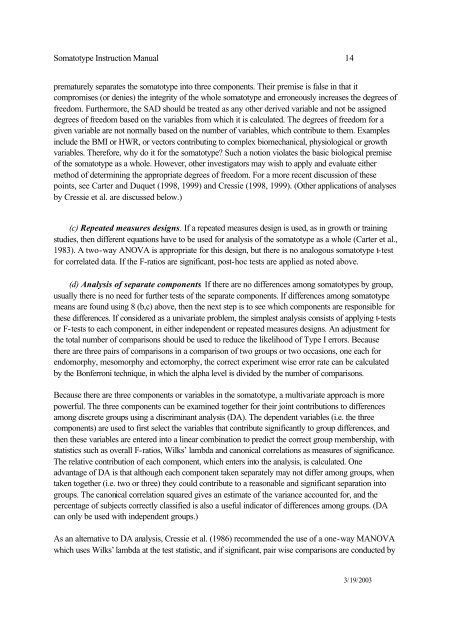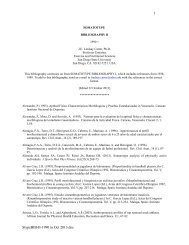THE HEATH-CARTER ANTHROPOMETRIC ... - Somatotype.org
THE HEATH-CARTER ANTHROPOMETRIC ... - Somatotype.org
THE HEATH-CARTER ANTHROPOMETRIC ... - Somatotype.org
You also want an ePaper? Increase the reach of your titles
YUMPU automatically turns print PDFs into web optimized ePapers that Google loves.
<strong>Somatotype</strong> Instruction Manual 14<br />
prematurely separates the somatotype into three components. Their premise is false in that it<br />
compromises (or denies) the integrity of the whole somatotype and erroneously increases the degrees of<br />
freedom. Furthermore, the SAD should be treated as any other derived variable and not be assigned<br />
degrees of freedom based on the variables from which it is calculated. The degrees of freedom for a<br />
given variable are not normally based on the number of variables, which contribute to them. Examples<br />
include the BMI or HWR, or vectors contributing to complex biomechanical, physiological or growth<br />
variables. Therefore, why do it for the somatotype? Such a notion violates the basic biological premise<br />
of the somatotype as a whole. However, other investigators may wish to apply and evaluate either<br />
method of determining the appropriate degrees of freedom. For a more recent discussion of these<br />
points, see Carter and Duquet (1998, 1999) and Cressie (1998, 1999). (Other applications of analyses<br />
by Cressie et al. are discussed below.)<br />
(c) Repeated measures designs. If a repeated measures design is used, as in growth or training<br />
studies, then different equations have to be used for analysis of the somatotype as a whole (Carter et al.,<br />
1983). A two-way ANOVA is appropriate for this design, but there is no analogous somatotype t-test<br />
for correlated data. If the F-ratios are significant, post-hoc tests are applied as noted above.<br />
(d) Analysis of separate components. If there are no differences among somatotypes by group,<br />
usually there is no need for further tests of the separate components. If differences among somatotype<br />
means are found using 8 (b,c) above, then the next step is to see which components are responsible for<br />
these differences. If considered as a univariate problem, the simplest analysis consists of applying t-tests<br />
or F-tests to each component, in either independent or repeated measures designs. An adjustment for<br />
the total number of comparisons should be used to reduce the likelihood of Type I errors. Because<br />
there are three pairs of comparisons in a comparison of two groups or two occasions, one each for<br />
endomorphy, mesomorphy and ectomorphy, the correct experiment wise error rate can be calculated<br />
by the Bonferroni technique, in which the alpha level is divided by the number of comparisons.<br />
Because there are three components or variables in the somatotype, a multivariate approach is more<br />
powerful. The three components can be examined together for their joint contributions to differences<br />
among discrete groups using a discriminant analysis (DA). The dependent variables (i.e. the three<br />
components) are used to first select the variables that contribute significantly to group differences, and<br />
then these variables are entered into a linear combination to predict the correct group membership, with<br />
statistics such as overall F-ratios, Wilks’ lambda and canonical correlations as measures of significance.<br />
The relative contribution of each component, which enters into the analysis, is calculated. One<br />
advantage of DA is that although each component taken separately may not differ among groups, when<br />
taken together (i.e. two or three) they could contribute to a reasonable and significant separation into<br />
groups. The canonical correlation squared gives an estimate of the variance accounted for, and the<br />
percentage of subjects correctly classified is also a useful indicator of differences among groups. (DA<br />
can only be used with independent groups.)<br />
As an alternative to DA analysis, Cressie et al. (1986) recommended the use of a one-way MANOVA<br />
which uses Wilks’ lambda at the test statistic, and if significant, pair wise comparisons are conducted by<br />
3/19/2003




